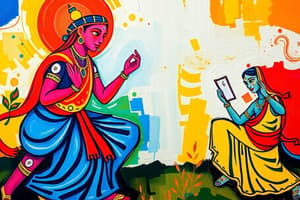Podcast
Questions and Answers
What are two genres found in Hindi literature?
What are two genres found in Hindi literature?
- Science Fiction and Thriller
- Biography and Comedy
- Romance and Mystery
- Poetry and Prose (correct)
Which period does Medieval Hindi literature refer to?
Which period does Medieval Hindi literature refer to?
- 3rd to 5th centuries AD
- 1st to 3rd centuries AD
- 19th to 21st centuries AD
- 6th to 18th centuries AD (correct)
What was a notable feature of medieval Hindi literature?
What was a notable feature of medieval Hindi literature?
- Roman Mythology
- Chinese Folklore
- Persian and Sanskrit influences (correct)
- Greek Philosophy
Which type of poetry was popular during the medieval period according to the text?
Which type of poetry was popular during the medieval period according to the text?
What is the Bhakti movement associated with in medieval Hindi literature?
What is the Bhakti movement associated with in medieval Hindi literature?
Which of the following did not influence medieval Hindi literature according to the text?
Which of the following did not influence medieval Hindi literature according to the text?
Who is credited with the compilation of ethical teachings in the Thirukkural in Tamil literature?
Who is credited with the compilation of ethical teachings in the Thirukkural in Tamil literature?
Which poet blended Islamic spirituality with Indian culture in medieval Hindi literature?
Which poet blended Islamic spirituality with Indian culture in medieval Hindi literature?
Who is known for using their writing to express resistance against oppressive regimes in modern Hindi literature?
Who is known for using their writing to express resistance against oppressive regimes in modern Hindi literature?
Which era of Hindi literature saw a rise in experimental forms like Surrealism and Expressionism?
Which era of Hindi literature saw a rise in experimental forms like Surrealism and Expressionism?
Which author from modern Hindi literature often addressed societal issues and themes of love, sacrifice, and betrayal?
Which author from modern Hindi literature often addressed societal issues and themes of love, sacrifice, and betrayal?
Who composed the Bhagavad Gita in Sanskrit during medieval times?
Who composed the Bhagavad Gita in Sanskrit during medieval times?
Study Notes
Introduction
Hindi literature is a diverse body of works written in the Hindi language, which is native to India and one of its official languages. This literature spans centuries, from ancient times up to modern day, and encompasses various genres including poetry, prose, drama, and fiction. In this article, we will delve into two periods of Hindi literature: medieval and modern, exploring their unique characteristics and contributions to the overall canon.
Medieval Hindi Literature
Medieval Hindi literature refers to the literary output during the medieval period of Indian history, which roughly corresponds to the period between the 6th and 18th centuries AD. During this time, Hindi literature was heavily influenced by Persian and Sanskrit traditions, resulting in a fusion of cultures and literary styles. Some notable features of medieval Hindi literature include:
Epic Poetry
Epic poetry was a popular form of expression during this period, with works like the Ramayana and the Mahabharata being among the most well-known examples. These epic poems are narrative poems that tell stories of gods, heroes, and King Rama, who according to Hindu tradition ruled over Ayodhya after his father's death.
Bhakti Movement
The Bhakti movement emerged in medieval Hindi literature, promoting devotion to God through love and service. This movement led to a surge in religious poetry, such as the Tamil poet-saint Thiruvalluvar's compilation of ethical teachings known as the Thirukkural, and the composition of the Bhagavad Gita by Sage Vyasa in Sanskrit.
Sufism Fusion
Sufism, the mystic branch of Islam prevalent in India, also played a significant role in medieval Hindi literature, particularly in the work of Amir Khusrau, the celebrated poet of the Delhi Sultanate. Khusrau's poetry reflects the syncretic nature of medieval Hindi literature, blending Islamic spirituality with Indian culture.
Modern Hindi Literature
Modern Hindi literature began to take shape from around the mid-19th century as a result of social changes brought about by the British colonial rule and the independence struggle. Key aspects of modern Hindi literature include:
Urdu influence
Influenced by Urdu literature, which evolved alongside it, modern Hindi literature saw a shift towards realistic themes and a focus on human emotions and experiences. Notable authors from this era include Munshi Premchand, whose works often dealt with societal issues and explored themes of love, sacrifice, and betrayal.
Political Awakening
Modern Hindi literature was also marked by a growing political awareness, with many writers using their works to express dissatisfaction with the status quo and to promote nationalist sentiments. Poets like Ram Prasad Bismil used their writing to articulate resistance against oppressive regimes and to inspire unity among the people.
Experimental Writing
In the latter half of the 20th century, modern Hindi literature saw a rise in experimental forms, such as Surrealism and Expressionism, reflected in the works of writers like Harivansh Rai Bachchan and Makhanlal Chaturvedi. These avant-garde movements challenged traditional forms of Hindi literature and paved the way for new artistic expressions.
Conclusion
From the intricate fusions of medieval Hindi literature to the politically charged and experimentally driven modern era, Hindi literature has continually adapted and evolve to reflect the changing socio-political landscape of India. It serves as a vibrant testament to the country's cultural heritage and linguistic diversity, offering insight into the hearts and minds of millions across generations.
Studying That Suits You
Use AI to generate personalized quizzes and flashcards to suit your learning preferences.
Description
Delve into the rich history of Hindi literature through the medieval and modern periods, exploring epic poems, the Bhakti movement, Urdu influences, political awakening, and experimental writing. Learn about the unique characteristics and contributions of each period to the diverse canon of Hindi literature.




